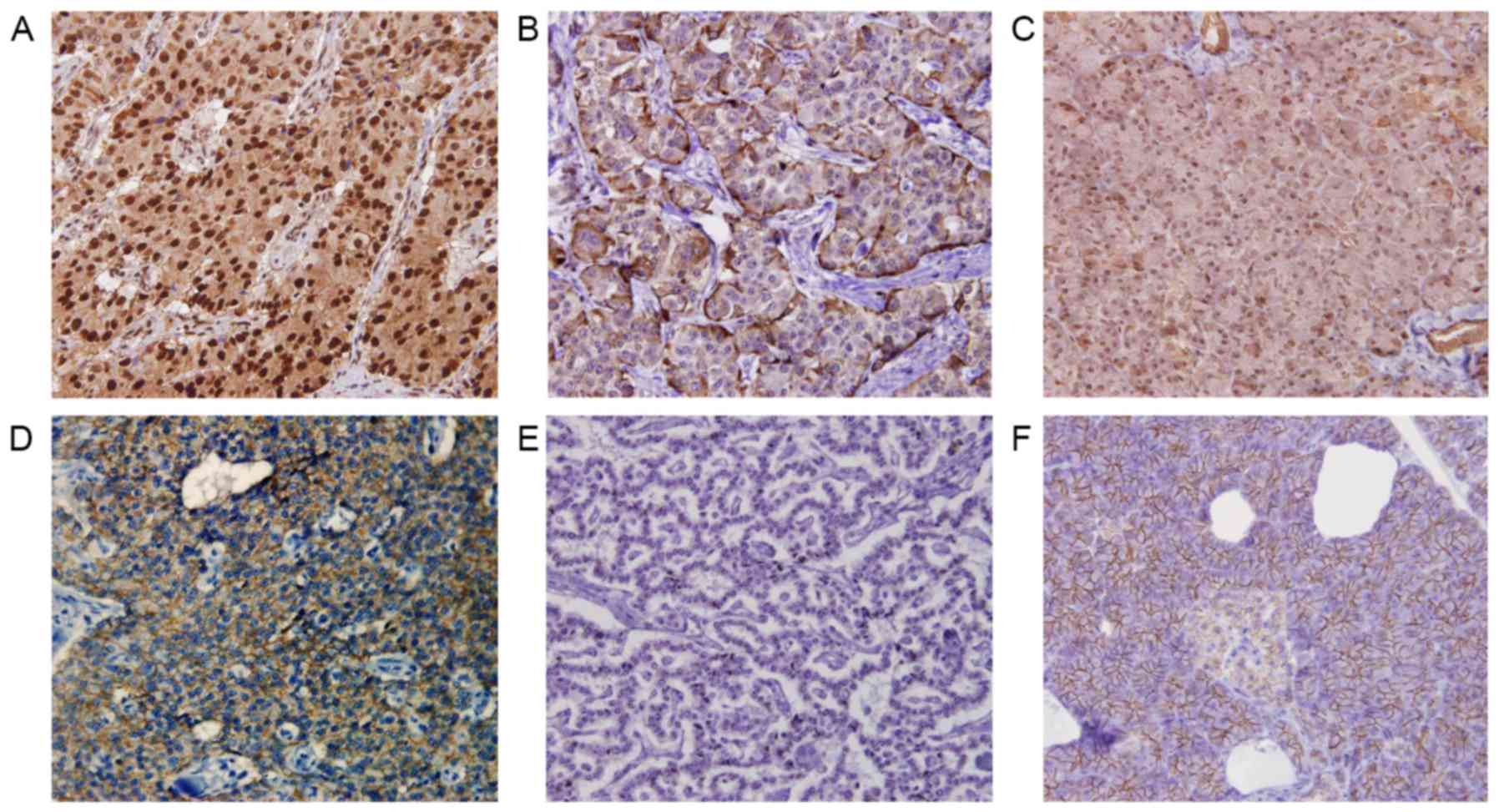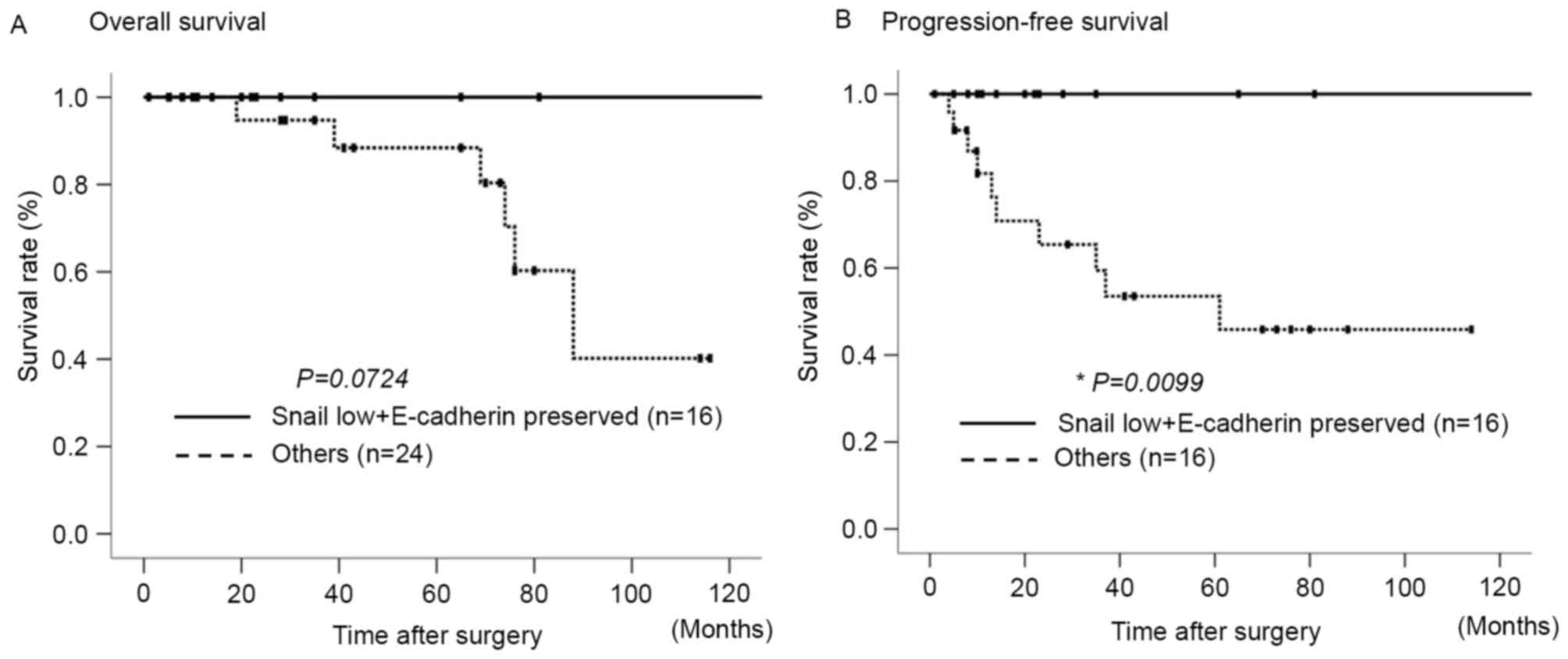|
1
|
Oberg K and Eriksson B: Endocrine tumours
of the pancreas. Best Pract Res Clin Gastroenterol. 19:753–781.
2005. View Article : Google Scholar : PubMed/NCBI
|
|
2
|
Klöppel G, Rindi G, Anlauf M, Perren A and
Komminoth P: Site-specific biology and pathology of
gastroenteropancreatic neuroendocrine tumors. Virchows Arch. 451
Suppl 1:S9–S27. 2007. View Article : Google Scholar : PubMed/NCBI
|
|
3
|
Metz DC and Jensen RT: Gastrointestinal
neuroendocrine tumors: Pancreatic endocrine tumors.
Gastroenterology. 135:1469–1492. 2008. View Article : Google Scholar : PubMed/NCBI
|
|
4
|
Bosman FT, Carneiro F, Hruban R and Theise
N: WHO Classification of Tumours of the Digestive System. 3. 4th.
IARC Press; 2010
|
|
5
|
Fischer L, Bergmann F, Schimmack S, Hinz
U, Prieß S, Müller-Stich BP, Werner J, Hackert T and Büchler MW:
Outcome of surgery for pancreatic neuroendocrine neoplasms. Br J
Surg. 101:1405–1412. 2014. View
Article : Google Scholar : PubMed/NCBI
|
|
6
|
Tsutsumi K, Ohtsuka T, Fujino M, Nakashima
H, Aishima S, Ueda J, Takahata S, Nakamura M, Oda Y and Tanaka M:
Analysis of risk factors for recurrence after curative resection of
well-differentiated pancreatic neuroendocrine tumors based on the
new grading classification. J Hepatobiliary Pancreat Sci.
21:418–425. 2014. View
Article : Google Scholar : PubMed/NCBI
|
|
7
|
Jiang JH, Liu C, Cheng H, Lu Y, Qin Y, Xu
YF, Xu J, Long J, Liu L, Ni QX and Yu XJ: Epithelial-mesenchymal
transition in pancreatic cancer: Is it a clinically significant
factor? Biochim Biophys Acta. 1855:43–49. 2015.PubMed/NCBI
|
|
8
|
Kalluri R and Weinberg RA: The basics of
epithelial-mesenchymal transition. J Clin Invest. 119:1420–1428.
2009. View
Article : Google Scholar : PubMed/NCBI
|
|
9
|
Maeda M, Johnson KR and Wheelock MJ:
Cadherin switching: Essential for behavioral but not morphological
changes during an epithelium-to-mesenchyme transition. J Cell Sci.
118:873–887. 2005. View Article : Google Scholar : PubMed/NCBI
|
|
10
|
Gunji N, Oda T, Todoroki T, Kanazawa N,
Kawamoto T, Yuzawa K, Scarpa A and Fukao K: Pancreatic carcinoma:
Correlation between E-cadherin and alpha-catenin expression status
and liver metastasis. Cancer. 82:1649–1656. 1998. View Article : Google Scholar : PubMed/NCBI
|
|
11
|
Nieto MA: The snail superfamily of
zinc-finger transcription factors. Nat Rev Mol Cell Biol.
3:155–166. 2002. View
Article : Google Scholar : PubMed/NCBI
|
|
12
|
Thomson S, Buck E, Petti F, Griffin G,
Brown E, Ramnarine N, Iwata KK, Gibson N and Haley JD: Epithelial
to mesenchymal transition is a determinant of sensitivity of
non-small-cell lung carcinoma cell lines and xenografts to
epidermal growth factor receptor inhibition. Cancer Res.
65:9455–9462. 2005. View Article : Google Scholar : PubMed/NCBI
|
|
13
|
Carver EA, Jiang R, Lan Y, Oram KF and
Gridley T: The mouse snail gene encodes a key regulator of the
epithelial-mesenchymal transition. Mol Cell Biol. 21:8184–8188.
2001. View Article : Google Scholar : PubMed/NCBI
|
|
14
|
Blanco MJ, Moreno-Bueno G, Sarrio D,
Locascio A, Cano A, Palacios J and Nieto MA: Correlation of Snail
expression with histological grade and lymph node status in breast
carcinomas. Oncogene. 21:3241–3246. 2002. View Article : Google Scholar : PubMed/NCBI
|
|
15
|
Rindi G, Klöppel G, Alhman H, Caplin M,
Couvelard A, de Herder WW, Erikssson B, Falchetti A, Falconi M,
Komminoth P, et al: TNM staging of foregut (neuro)endocrine tumors:
A consensus proposal including a grading system. Virchows Arch.
449:395–401. 2006. View Article : Google Scholar : PubMed/NCBI
|
|
16
|
Birnbaum DJ, Turrini O, Vigano L,
Russolillo N, Autret A, Moutardier V, Capussotti L, Le Treut YP,
Delpero JR and Hardwigsen J: Surgical management of advanced
pancreatic neuroendocrine tumors: Short-term and long-term results
from an international multi-institutional study. Ann Surg Oncol.
22:1000–1007. 2015. View Article : Google Scholar : PubMed/NCBI
|
|
17
|
Saeed A, Buell JF and Kandil E: Surgical
treatment of liver metastases in patients with neuroendocrine
tumors. Ann Transl Med. 1:62013.PubMed/NCBI
|
|
18
|
Hotz B, Arndt M, Dullat S, Bhargava S,
Buhr HJ and Hotz HG: Epithelial to mesenchymal transition:
Expression of the regulators snail, slug, and twist in pancreatic
cancer. Clin Cancer Res. 13:4769–4776. 2007. View Article : Google Scholar : PubMed/NCBI
|
|
19
|
Kurahara H, Takao S, Maemura K, Mataki Y,
Kuwahata T, Maeda K, Ding Q, Sakoda M, Iino S, Ishigami S, et al:
Epithelial-mesenchymal transition and mesenchymal-epithelial
transition via regulation of ZEB-1 and ZEB-2 expression in
pancreatic cancer. J Surg Oncol. 105:655–661. 2012. View Article : Google Scholar : PubMed/NCBI
|
|
20
|
Izumi H, Hirabayashi K, Nakamura N and
Nakagohri T: Nectin expression in pancreatic adenocarcinoma:
Nectin-3 is associated with a poor prognosis. Surg Today.
45:487–494. 2015. View Article : Google Scholar : PubMed/NCBI
|
|
21
|
Fendrich V, Maschuw K, Waldmann J,
Buchholz M, Rehm J, Gress TM, Bartsch DK and König A:
Epithelial-mesenchymal transition is a critical step in
tumorgenesis of pancreatic neuroendocrine tumors. Cancers (Basel).
4:281–294. 2012. View Article : Google Scholar : PubMed/NCBI
|
|
22
|
Galvan JA, Astudillo A, Vallina A, Fonseca
PJ, Gómez-Izquierdo L, García-Carbonero R and González MV:
Epithelial-mesenchymal transition markers in the differential
diagnosis of gastroenteropancreatic neuroendocrine tumors. Am J
Clin Pathol. 140:61–72. 2013. View Article : Google Scholar : PubMed/NCBI
|
|
23
|
Therasse E, Breittmayer F, Roche A, De
Baere T, Indushekar S, Ducreux M, Lasser P, Elias D and Rougier P:
Transcatheter chemoembolization of progressive carcinoid liver
metastasis. Radiology. 189:541–547. 1993. View Article : Google Scholar : PubMed/NCBI
|
|
24
|
Ruszniewski P, Rougier P, Roche A, Legmann
P, Sibert A, Hochlaf S, Ychou M and Mignon M: Hepatic arterial
chemoembolization in patients with liver metastases of endocrine
tumors. A prospective phase II study in 24 patients. Cancer.
71:2624–2630. 1993. View Article : Google Scholar : PubMed/NCBI
|
|
25
|
Lee E, Pachter H Leon and Sarpel U:
Hepatic arterial embolization for the treatment of metastatic
neuroendocrine tumors. Int J Hepatol. 2012:4712032012. View Article : Google Scholar : PubMed/NCBI
|












